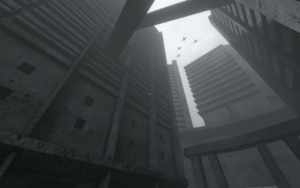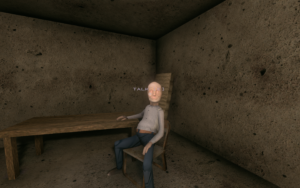
For this week’s playtest, I played BABBDI, a dark/ominous walking simulator created by the Lemaitre Bros and accessible through Steam. After quickly reading about the game, I was immediately intrigued by the creepy, eerie imagery and tone of the game–which reminded me of “Slenderman,” a mobile walking game I played as a child. This game seems targeted to teens and older, who are looking for a sense of exploration, discovery, and fear!
This is a first-person, single-player exploration game the that takes place in a city/abandoned world of Babbdi where all the inhabitants want to escape. Throughout the narrative (or the first hour that I played), you explore the world and attempt to escape. It is a goal-driven narrative (escape) and it is relatively zero-sum competition: you either escape or don’t. Unlike other walking simulators, there are not extensive side quests to focus on. The game aims to promote discovery, which is emphasized through the aesthetic of an ominous narrative, sound, and mood creation (lighting/colors/etc). The scary nature of the game makes the process of exploring the world unnerving, but also exciting. (As the game goes on and you learn more and feel comfortable, you have to go explore more of the terrain that puts you back in discomfort.)
Further, the dynamic of requiring a player to progressively talk to new citizens/inhabitants allows the narrative to evolve over time. As noted in the article, this walking game “lacks puzzles or any sort of barrier to experiencing the narrative, with the exception of finding objects”. The game allows you to simply move through the world and interact with people to progress the plot forward:

The ominous aesthetic of the game is emphasized by the first person POV. Third person POV would allow the player to see if there is something immediately behind them. Here, we have a slightly confined view that requires us to physically shift our perspective to see. Much like the confined sense of context/baddbi, our POV is similarly confined that creates a sense of lack of control, claustrophobic, and zero-omnipresence. To this extent, I found the game mechanics of walking/limited POV to be extremely effective.
Despite this, I’d also like to explore where this walking mechanic failed. The open world of the game works incredibly well early on. I immediately was fascinated by the ominous villagers and departed on my own walking adventure about 10 minutes into playing. The world is so beautifully constructed and I appreciated the opportunity to explore (instead of being pigeonholed into a specific narrative). However, I quickly became bored. The longer I played, the more I found the ominous language of the villagers annoying, repetitive, and dull. I found myself constantly looking for hints as to how I should move forward and the vague responses from villagers “stopped” becoming eerie. Instead, they became monotonous and frustrated.
The aesthetic of vague language of the citizens and dynamic of required talking to discover the world quickly became at odds. As a player, I must interact with people to learn what I can, but each conversation is dull, short, and does not reveal information. An improvement to the game would be to find ways to build the context of the world/stakes by having these villagers engage more with the player (via anecdotes, scary stories, etc) rather that vague language like “we must escape”.
Further, the drama felt less pressing. Consider Slenderman, where the player is immediately tasked with a clear objective that requires exploration (find the notes), with a Slenderman that is constantly looming and engaging with the player from the very beginning. The rules/game of Slenderman is established very quickly, you must try to find the notes and there will be a scary element at every turn. With Babbdi, the focus on a long-form narrative that requires multiple hours of play–paired with the little information we get throughout the story–makes the stakes of the game low at the beginning and struggle to gain momentum. By comparison, Slenderman has a much faster place, with clear objectives for the walking mechanic from the beginning, and therefore establishes stakes immediately.




